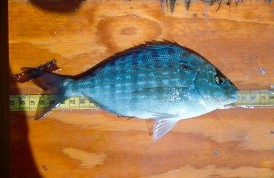
Seagrass beds provide food and shelter for many fish species. However, the manner in which fishes use seagrass bed habitats often varies with life stage. Juvenile fishes can be especially dependent on seagrass beds because seagrass and associated habitats (drift macroalgae) may provide an effective tradeoff between shelter from predation and availability of prey. This study addressed aspects of habitat use by post-settlement pinfish, Lagodon rhomboides, an abundant and trophically important species in seagrass beds in the western North Atlantic. Abundance of post-settlement fish in seagrass beds was positively related to volume of drift macroalgae, but not to percent cover of seagrass, indicating a possible shelter advantage of the spatially complex algae. Tethering experiments indicated higher rates of predation in seagrass without drift macroalgae than in seagrass with drift macroalgae. Aquarium experiments showed lower predation with higher habitat complexity, but differences were only significant for the most extreme cases (unvegetated bottom, highest macrophyte cover). Levels of dissolved oxygen did not differ between vegetated and unvegetated habitats, indicating no physiological advantage for any habitat. Seagrass beds with drift macroalgae provide the most advantageous tradeoff between foraging and protection from predation for post-settlement L. rhomboides. The complex three-dimensional shelter of drift macroalgae provides an effective shelter that is embedded in the foraging habitat provided by seagrass. Drift macroalgae in seagrass beds is a beneficial habitat for post-settlement L. rhomboides by reducing the risk of predation, and by providing post-settlement habitat within the mosaic (seagrass beds) of adult habitat, thus reducing risks associated with ontogenetic habitat shifts.


